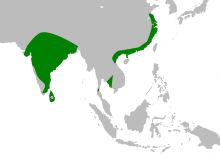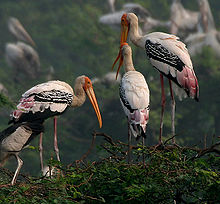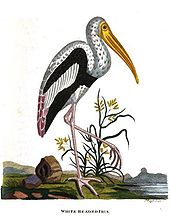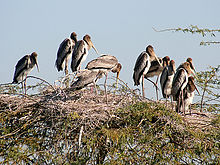- Painted Stork
-
Painted Stork 
Adult at Bharatpur Bird Sanctuary, India Conservation status Scientific classification Kingdom: Animalia Phylum: Chordata Class: Aves Order: Ciconiiformes Family: Ciconiidae Genus: Mycteria Species: M. leucocephala Binomial name Mycteria leucocephala
(Pennant, 1769)
Synonyms Tantalus leucocephalus
Ibis leucocephalus
Pseudotantalus leucocephalusThe Painted Stork (Mycteria leucocephala) is a large wading bird in the stork family. It is found in the wetlands of the plains of tropical Asia south of the Himalayas in South Asia and extending into Southeast Asia. Their distinctive pink tertial feathers give them their name. They forage in flocks in shallow waters along rivers or lakes. They immerse their half open beaks in water and sweep them from side to side and snap up their prey of small fish that are sensed by touch. As they wade along they also stir the water with their feet to flush hiding fish. They nest colonially in trees, often along with other waterbirds. They only sounds they produce are a weak moan or sounds produced by bill clattering. They are not migratory and only make short distance movements in some parts of their range in response to food and for breeding. Like other storks, they are often seen soaring on thermals.
Contents
Description
This large stork has a heavy yellow bill with a down-curved tip that gives it a resemblance to an ibis. The head of the adult is bare and orange or reddish in colour. The long tertials are tipped in bright pink and at rest they extend over the back and rump. There is a distinctive black breast band with white scaly markings. The band continues into the underwing coverts and the white tips of the black coverts give it the appearance of white stripes running across the underwing lining. The rest of the body is whitish in adults and the primaries and secondaries are black with a greenish gloss. The legs are yellowish to red but often appear white due their habit of urohidrosis or defecating on their legs especially when at nest. The short tail is black with a green gloss.[2] For a stork, it is medium-sized, standing about 93–102 cm (37–40 in) tall, 150–160 cm (59–63 in) in wingspan and weighing 2-3.5 kg (4.4-7.7 lbs). Males and females appear alike but the males of a pair are usually larger than the female.[3]
The downy young are mainly whitish with grey bills and blackish facial skin. The juveniles assume a brownish plumage and like most other storks reach breeding condition after two to three years.[4]
Like all storks, they fly with their neck outstretched. They often make use of the late morning thermals to soar in search of foraging areas.
Taxonomy
In the past the species has been placed in the genus Ibis, Tantalus and Pseudotantalus. The name Tantalus is derived from Greek mythology.[5] T C Jerdon called it the "Pelican Ibis".[6] It was later placed along with the wood-storks to which it shows behavioural similarities[7] and the affinity has been confirmed by sequence based studies.[8][9]
Distribution and habitat
The Painted Stork is widely distributed over the plains of Asia. They are found south of the Himalayan ranges and are bounded on the west by the Indus river system where they are rare and extend eastwards into Southeast Asia. They are absent from very dry or desert regions, dense forests and the higher hill regions. They are rare in most of Kerala and the species appears to have expanded into that region only in the 1990s.[10][11] They are mainly seen on freshwater wetlands although they sometimes forage on the coast. They are resident in most regions but make seasonal movements.[12] Young birds may disperse far from their breeding sites and a juvenile ringed at nest in Keoladeo National Park has been recovered 800 kilometres away in eastern India.[4]
Behaviour and ecology
Painted Storks feed in groups in shallow wetlands. The preferred depth is about 12 to 25 cm of water and deeper waters are avoided. They feed mainly on small fish which they sense by touch while slowly sweeping their half open bill from side to side while it held submerged. They walks slowly and also disturb the water with their feet to flush fish.[13] They also take frogs and the occasional snake.[14] They forage mainly in the day but may forage late or even at night under exceptional conditions.[15] After they are fed they may stand still on the shore for long durations.[16]
They breed in trees along with other water birds. The platform nests are typically placed in a tree on an island or in an otherwise undisturbed area. The best nesting sites are at the tops of the trees and birds jostle for these locations. In some areas where they have been left undisturbed they nest very close to human habitations.[12]
The breeding season begins in the winter months shortly after the monsoons. In northern India, the breeding season begins in mid-August[17] while in southern India the nest initiation begins around October[18] and continues till February[19] and or even until April.[12][20] A lot of variation is noticed in the onset of breeding across sites with the season at Kokrebellur and Edurupattu around January or February but at Telineelapuram, Kundakulam and Tirunelveli the breeding begins around October or November.[18] Predation of eggs is mainly by crows and while very young chicks were sometimes attacked by crows, the older chicks were attacked by Black Kites. The typical clutch varies from 2 to 5 eggs with early breeders having larger clutches.[21] The incubation period is about a month while the fledging period is nearly two months.[22][23] The occasional predation of chicks by migrant Aquila eagles has been observed.[24] During the mid-day heat, adults will stand at the nest with wings outstretched to shade the chicks. To feed chicks, adults regurgitate fish that they have caught and these are typically smaller than 20 cm long.[13] The daily requirement for chicks has been estimated to be about 500 grams made up of about 9 fish fed in two sessions.[4]
The bare red skin on the head is developed when reaching breeding maturity and involves the loss of feathers and the deposition of lipids under the skin.[25] Birds in captivity have been known to live for as many as 28 years.[4]
A bird louse, Ardeicola tantali is described on the basis of a specimen obtained from this species[26] as is a subcutaneous mite, Neottialges kutzeri, of the family Hypoderidae.[27]
Conservation
Painted Storks being large and colourful birds and their nesting colonies become centres of tourist interest. Particularly well-known nest site are those that are close to human settlements and these include the colony in the south Indian villages of Kokrebellur and Veerapura. In Kokrebellur, the birds nest within the trees in the village forming mixed nesting colonies with the Spot-billed Pelican. The local people provide security to these birds during the brief nesting season when the birds arrive in October leaving the village in a couple of months.[28][29][30]
Another well-known colony that has been studied since the 1960s includes one inside the New Delhi Zoological Garden where the birds arrive about 30–40 days after the onset of the Monsoons in Delhi.[31] This colony is made up of 300 to 600 wild birds that make use of the trees within the artificial islands inside the zoo.[21] Uppalapadu village near Guntur in Andhra Pradesh, Kolleru[32] and Ranganathittu are among the many other breeding colonies known from southern India.[33][34]
Captive birds are known to breed readily when provided with nesting materials and platforms.[35][36] The largest secure population is found in India. Birds in Pakistan along the Indus river system are endangered and chicks at their nests are taken away for the bird trade. The species was nearly decimated in Thailand while small populations are known from Cambodia and Vietnam.[4]
References
- ^ BirdLife International (2008). Mycteria leucocephala. In: IUCN 2008. IUCN Red List of Threatened Species. Downloaded on 2 February 2009.
- ^ Rasmussen, PC & JC Anderton (2005). Birds of South Asia: The Ripley Guide. Volume 2.. Smithsonian Institution & Lynx Edicions. p. 62.
- ^ Urfi, A. J. & A. Kalam (2006). "Sexual Size Dimorphism and Mating Pattern in the Painted Stork (Mycteria leucocephala)". Waterbirds 29 (4): 489–496. doi:10.1675/1524-4695(2006)29[489:SSDAMP]2.0.CO;2.
- ^ a b c d e Elliott, A. (1992). "Family Ciconiidae (Storks)". In del Hoyo, J.; A. Elliott, J. Sargatal. Handbook of the Birds of the World. Vol. 1. Lynx Edicions, Barcelona. pp. 449–458.
- ^ Le Messurier, A. (1904). Game, shore and water birds of India. 4th Edition. W Thacker and Co.. p. 193. http://www.archive.org/stream/gamesshoreandwat029723mbp#page/n196/mode/1up/search/Painted+Stork.
- ^ Burgess, Lieut. (1855). "Notes on the habits of some Indian Birds". Proceedings of the Zoological Society of London 23: 70–74. http://www.archive.org/stream/proceedings37londgoog#page/n92/mode/1up.
- ^ Kahl, MP (1972). "Comparative ethology of the Ciconiidae. The Wood-storks (Genera Mycteria and Ibis)". Ibis 114 (1): 15–29. doi:10.1111/j.1474-919X.1972.tb02586.x.
- ^ Sheldon, Frederick H.; Beth Slikas (1997). "Advances in Ciconiiform Systematics 1976-1996". Colonial Waterbirds 20 (1): 106–114. doi:10.2307/1521772. JSTOR 1521772.
- ^ Slikas, B (1998). "Recognizing and testing homology of courtship displays in storks (Aves: Ciconiiformes: Ciconiidae)". Evolution 52 (3): 884–893. doi:10.2307/2411283. JSTOR 2411283.
- ^ Sashi Kumar,C; Jayakumar,C; Jaffer,Muhammed (1991). "Glossy Ibis Plegadis falcinellus (Linn.) and Painted Stork Mycteria leucocephala (Pennant): two more additions to the bird list of Kerala". J. Bombay Nat. Hist. Soc. 88 (1): 110.
- ^ Sathasivam, Kumaran (1992). "Painted Stork Mycteria leucocephala (Pennant) in Kerala". J. Bombay Nat. Hist. Soc. 89 (2): 246.
- ^ a b c Whistler, Hugh (1940). Popular handbook of Indian Birds. Fourth edition.. Gurney and Jackson, London. pp. 503–505. http://www.archive.org/stream/popularhandbooko033226mbp#page/n551/mode/2up/.
- ^ a b Kalam, A & A. J. Urfi (2008). "Foraging behaviour and prey size of the painted stork". Journal of Zoology 274 (2): 198–204. doi:10.1111/j.1469-7998.2007.00374.x.
- ^ Urfi,Abdul Jamil (1989). "Painted Stork Mycteria leucocephala (Pennant) swallowing a snake". J. Bombay Nat. Hist. Soc. 86 (1): 96.
- ^ Kannan V & R. Manakadan (2007). "Nocturnal foraging by Painted Storks Mycteria leucocephala at Pulicat Lake, India". Indian Birds 3 (1): 25–26. http://www.pulicatlake.org/Indian%20Birds.pdf.
- ^ Ali S & S D Ripley (1978). Handbook to the birds of India and Pakistan. 1 (2 ed.). Oxford University Press=93-95. ISBN 0195620631.
- ^ Urfi, AJ; T Meganathan & A Kalam (2007). "Nesting ecology of the Painted Stork Mycteria leucocephala at Sultanpur National Park, Haryana, India". Forktail 23: 150–153.
- ^ a b Bhat, H. R., P. G. Jacob and A. V. Jamgaonkar (1990). "Observations on a breeding colony of Painted Stork Mycteria leucocephala (Pennant) in Anantapur District, Andhra Pradesh". Journal of Bombay Natural History of Society 88: 443–445.
- ^ Hume, AO (1890). The nests and eggs of Indian Birds. Volume 3. Second edition.. R H Porter. pp. 220–223. http://www.archive.org/stream/nestseggsofindia03humerich#page/220/mode/1up/search/Tantalus.
- ^ Urfi, AJ (1993). "Breeding Patterns of Painted Storks (Mycteria leucocephala Pennant) at Delhi Zoo, India". Colonial Waterbirds 16 (1): 95–97. doi:10.2307/1521563. JSTOR 1521563.
- ^ a b Meganathan, Thangarasu and Abdul Jamil Urfi (2009). "Inter-Colony Variations in Nesting Ecology of Painted Stork (Mycteria leucocephala) in the Delhi Zoo (North India)". Waterbirds 32 (2): 352–356. doi:10.1675/063.032.0216.
- ^ Meiri, S & Y. Yom-Tov (2004). "Ontogeny of large birds: Migrants do it faster". The Condor 106 (3): 540–548. doi:10.1650/7506. http://mondrian.tau.ac.il/lifesci/zoology/members/dayan_files/articles/Ontogeny.pdf.
- ^ Urfi, AJ (2003). "Record of a nesting colony of painted stork Mycteria leucocephala at Man-Marodi Island in the Gulf of Kutch". J. Bombay Nat. Hist. Soc. 100: 109–110.
- ^ Sundar, KSG (2005). "Predation of fledgling Painted Stork Mycteria leucocephala by a Spotted Eagle Aquila spp. in Sultanpur National Park, Haryana". Indian Birds 1 (6): 144–145. http://www.indianbirds.in/pdfs/IB.1.6.Final.pdf.
- ^ Menon, Gopinathan K. & Jaishri Menon (2000). "Avian Epidermal Lipids: Functional Considerations and Relationship to Feathering". Amer. Zool. 40 (4): 540–552. doi:10.1093/icb/40.4.540.
- ^ Clay, Theresa & GHE Hopkins (1960). "The early literature on mallophaga (part 4, 1787-1818)". Bulletin of the British Museum. Entomology 9 (1): 1–61. http://www.archive.org/stream/bulletinofnatura09entolond#page/10/mode/2up/search/Tantalus.
- ^ Pence, DB (1973). "Hypopi (Acarina: Hypoderidae) from the subcutaneous tissues of the wood ibis, Mycteria americana L". Journal of Medical Entomology 10 (3): 240–243. PMID 4719286.
- ^ Ayub, Akber (2008). "A curious kinship". Life positive: 38–40. http://www.lifepositive.com/Emagazinepdf/June2008/Page38.pdf.
- ^ Neginhal,SG (1993). "The bird village". Sanctuary Asia 13 (4): 26–33.
- ^ Neginhal, SG (1977). "Discovery of a pelicanry in Karnataka". J. Bombay Nat. Hist. Soc. 74 (1): 169–170.
- ^ Urfi, A. J. (1998). "A monsoon delivers storks". Natural History 107: 32–39.
- ^ Pattanaik C; SN Prasad; N Nagabhatla; CM Finlayson (2008). "Kolleru regains its grandeur". Current Science 94 (1): 9–10. http://www.ias.ac.in/currsci/jan102008/9.pdf.
- ^ Pattanaik, C; S N Prasad; EN Murthy ; C S Reddy (2008). "Conservation of Painted Stork habitats in Andhra Pradesh". Current Science 95 (8): 1001. http://www.ias.ac.in/currsci/oct252008/1001.pdf.
- ^ Subramanya S (2005). "Heronries of Tamil Nadu". Indian Birds 1 (6): 126–140. http://www.indianbirds.in/pdfs/IB.1.6.Final.pdf.
- ^ Devkar, RV, JN Buch, PS Khanpara & R D Katara (2006). "Management and monitoring of captive breeding of Painted Stork and Eurasian Spoonbill in zoo aviary". Zoos' Print Journal 21 (3): 2189–2192. http://www.zoosprint.org/ZooPrintJournal/2006/March/2189-2192.pdf.
- ^ Weinman,AN (1940). "Breeding of the Indian Painted Stork under semi-domestication". Spolia Zeylanica 22 (1): 141–144.
Other source
- Chaleow Salakij, Jarernsak Salakij, Nual-Anong Narkkong, Decha Pitakkingthong and Songkrod Poothong (2003) Hematology, Morphology, Cytochemistry and Ultrastructure of Blood Cells in Painted Stork (Mycteria leucocephala). Kasetsart J. (Nat. Sci.) 37:506-513
- Urfi, A. J. 1997. The significance of Delhi Zoo for wild water birds, with special reference to the Painted Stork (Mycteria leucocephala). Forktail 12:87–97.
- Shah,RV; Menon,GK; Desai,JH; Jani,MB (1977) Feather loss from capital tracts of Painted Storks related to growth and maturity: 1. Histophysiological changes and lipoid secretion in the integument. J. Anim. Morphol. Physiol. 24(1):99-107
External links
Storks (order: Ciconiiformes • family: Ciconiidae) Genus Mycteria Milky Stork (M. cinerea) • Yellow-billed Stork (M. ibis) • Painted Stork (M. leucocephala) • Wood Stork (M. americana)Anastomus Ciconia Abdim's Stork (C. abdimii) • Woolly-necked Stork (C. episcopus) • Storm's Stork (C. stormi) • Maguari Stork (C. maguari) • Oriental Stork (C. boyciana) • White Stork (C. ciconia) • Black Stork (C. nigra)Ephippiorhynchus Jabiru Leptoptilos 19 living species in six generaCategories:- IUCN Red List near threatened species
- Mycteria
- Birds of Asia
- Birds of Southeast Asia
Wikimedia Foundation. 2010.














